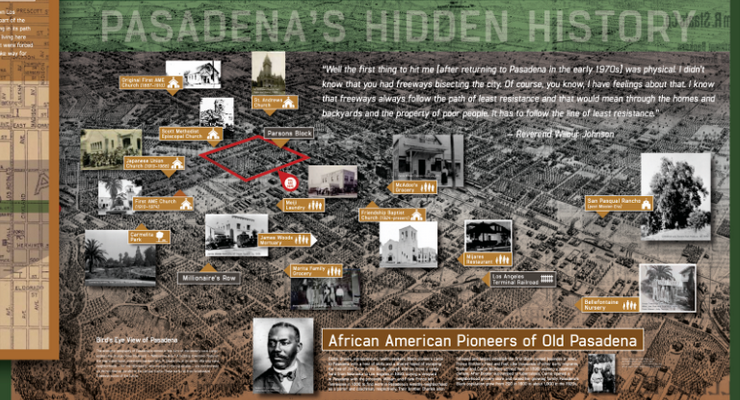
A historical art installation and monument consisting of ten bronze interpretive plaques along a walk emanating from the new 100 West Walnut development in Old Pasadena and around the 134/210 freeway interchange was dedicated in a ceremony at the site Thursday.
The plaques highlight the history of the African-American, Asian-American and Latino populations whose communities were displaced with the construction of the freeways in Pasadena in the late 60s and early 70s.
The monument and installation were spearheaded by Councilmember John Kennedy who stipulated in 2017, in voting to approve the historic one million square-foot development in the northwest portion of Old Pasadena development on the former Parsons Engineering site, that the history of its former population and inhabitants be acknowledged and permanently commemorated.
The installation is a collaboration between Lincoln Properties, developers of the project, Hunt Design and the City of Pasadena. The plaques themselves were conceived and written by Heather Lindquist, and designed by Jennifer Bresler of Hunt Design.
“This monument,” Kennedy said Thursday, “culminates a relationship not between one councilmember and the developer, but the city council and our mayor, and a development agreement that required this particular recognition of historical wrongs that took place in the City of Pasadena.”
Friendship Pasadena Church Pastor Lucious W. Smith said of the neighborhood the “our story is like a book with pages torn out,” and continued to day that the plaques and acknowledgments within them would help to right some historic wrongs.
Longtime educator Alma Stokes, a Pasadena resident since 1953, recalled the days when “Urban Renewal” meant displacing local neighborhoods and populations of color. She said she once worked in the City’s Relocation Department.
“I had to move people out of their beautiful homes,” she remembered. “The people in that community even had their own credit union. That’s the kind of thing that was going on in the Black community. I came to find out, though, that relocation was really just Black removal, so I left that.”
Bryan Takeda of Pasadena Sister Cities spoke about the impact of the interment of the Japanese-American population.
“There were all these cars parked one morning at the Rose Bowl, filled with Japanese-Americans getting ready to drive themselves to the camps,” he told the gathering.
Historian Roberta Martinez went much further back, recalling the existence of the early Tongva and Gabrielino tribes of the area, also referred to as “Kizh.”
The plaques, which are anchored at Leonard J. Pieroni Stree and W. Holly Street and continue north and south through the Old Pasadena neighborhood, highlight various aspects of the removal of neighborhoods to build freeways and facilitate what was considered progress.
Among the historical issues detailed in the plaques are:
- “Remembering Real People, Places, and Faces”
- “Building Freeways, Dividing Communities”
- “Exploring Pasadena’s Past”
- Mapping Prejudice in Pasadena”
- “Keeping the Faith”
- “At Home in Old Pasadena”
- “Pioneers and Entrepreneurs”
- “Paces Change, People Endure”
- “Before the Freeways”
- “Forced From Home”
The historical trail of issues and real-life stories is a candid and raw look at the price of Pasadena’s history and progress and its impact on the lives involved.














 0 comments
0 comments




